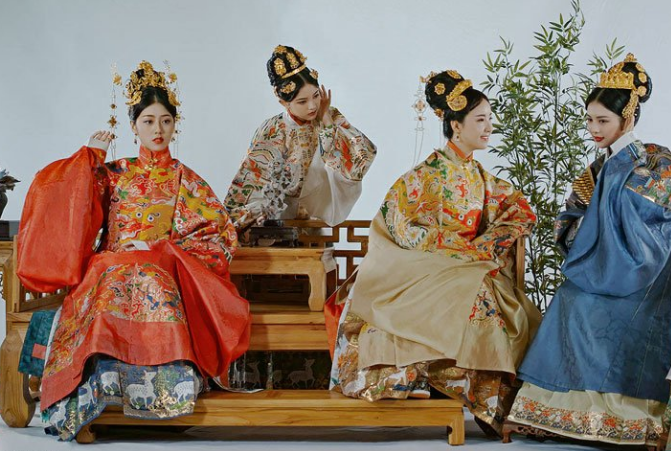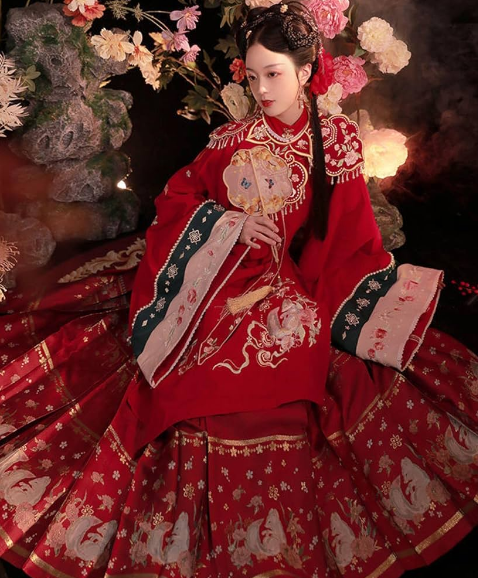The imagery on Hanfu represents rich Chinese cultural symbolism, conveying historical narratives, values, and beliefs through intricate patterns.
Hanfu Imagery
Hanfu, the traditional attire of the Han Chinese people, stands as a vivid symbol of China’s rich cultural heritage. It’s a fusion of art, history, and identity, woven into the very fabric of these garments.
Historical Origins of Hanfu
Tracing its roots back to the earliest dynasties, Hanfu dates back over 3,000 years. The Shang Dynasty, renowned for its bronze work, saw the inception of silk Hanfu. This era laid the foundation for the intricate designs and patterns that would evolve over centuries. Each dynasty thereafter left its unique imprint on Hanfu, with the Tang Dynasty being particularly noted for its vibrant, cosmopolitan styles, reflecting the dynasty’s openness to foreign influences.

Common Themes in Hanfu Designs
Hanfu designs are not mere decorations; they’re a canvas narrating stories and values. Floral motifs, like peonies and lotuses, often symbolize wealth and purity, respectively. Dragons, a recurring theme, epitomize power and imperial authority. Beyond these, colors in Hanfu hold deep meanings. Red, for instance, is associated with good fortune and joy, while blue reflects calmness and stability.
Cultural Significance of Hanfu Patterns
Every stitch and pattern in Hanfu is laden with cultural significance. For instance, the ‘yunjian’, a cloud-shoulder design, represents the sky and a connection to the celestial. The use of ‘ruyi’ patterns, a symbol of good fortune and longevity, is common in Hanfu, especially in garments worn for special occasions. These patterns are not just aesthetic choices; they’re a dialogue with history, a respect for tradition, and a celebration of Chinese culture.
In crafting this narrative, Hanfu transcends its role as mere clothing. It becomes a living, evolving testament to the enduring spirit of Chinese civilization. Through its designs, Hanfu conveys stories of emperors and commoners alike, bridging the past with the present, and carrying forward the legacy of one of the world’s oldest cultures.
Symbolism in Hanfu Patterns
Hanfu patterns are more than just art; they are a language that speaks of history, culture, and philosophy. Each pattern woven into Hanfu carries a deep symbolic meaning, often reflecting the values and beliefs of ancient China.
Floral Motifs
Floral motifs in Hanfu are not random; they are deliberate symbols. The peony, often seen in Hanfu, represents wealth and honor. It’s especially prominent during festive occasions like the Lunar New Year. The lotus, symbolizing purity and enlightenment, is a favored design in religious ceremonies. Chrysanthemums, denoting longevity, are common in autumn festivals. These floral designs are a celebration of nature’s beauty and a reflection of the philosophical views of the Chinese people.
Animal Imagery
Dragons and phoenixes in Hanfu embody strength and grace. The dragon, a symbol of power and good luck, is often reserved for imperial attire. The phoenix, representing beauty and harmony, is a common motif in wedding Hanfu, symbolizing a harmonious marriage. Cranes, symbolizing longevity, are popular in elder’s clothing. These animal motifs are not just decorative; they are a nod to the rich mythology and cultural beliefs of China.
Geometric Patterns and Their Cultural Connotations
Geometric patterns in Hanfu, like circles and squares, hold their unique meanings. Circles represent unity and perfection, often used in Hanfu worn for family gatherings. Squares, symbolizing stability and balance, are common in everyday Hanfu. The use of these geometric patterns is a subtle yet profound reflection of the Chinese philosophical emphasis on balance and harmony in life.
In exploring these patterns, one dives deep into the essence of Chinese culture. Hanfu patterns are a testament to the enduring legacy of Chinese aesthetics, philosophy, and values. They are not merely clothing; they are a canvas where the past and present, the human and the divine, intertwine.
Regional Variations in Hanfu Imagery
The Hanfu, a symbol of Chinese cultural identity, exhibits remarkable diversity in its designs and styles, reflecting the rich tapestry of China’s regional cultures. These variations not only showcase the aesthetic diversity but also tell stories of local climates, resources, and historical influences.
Northern vs. Southern Hanfu Styles
In the North, where winters are harsh, Hanfu typically features heavier fabrics like wool and brocade, designed to provide warmth. The styles are often more reserved, with darker colors predominating. In contrast, the Southern Hanfu, adapted to a warmer, more humid climate, favors lighter materials such as silk and linen. Bright, vibrant colors and elaborate embroidery characterize these garments, reflecting the South’s lush landscapes and vibrant cultural life.
Influence of Dynastic Changes on Hanfu Designs
Each Chinese dynasty has left an indelible mark on Hanfu styles. For example, the Tang Dynasty, known for its cultural openness, introduced wider sleeves and brighter colors, reflecting the cosmopolitan nature of its society. The Ming Dynasty, on the other hand, favored more structured designs with stand-up collars, reflecting a return to traditional values. These changes in Hanfu over different dynasties not only represent shifts in fashion but also mirror the political, social, and cultural transformations of the times.
Modern Interpretations of Traditional Imagery
Today, there’s a resurgence of interest in Hanfu, with designers blending traditional patterns with contemporary fashion sensibilities. This modern Hanfu movement is not just about reviving old styles; it’s a reimagining of traditional imagery to fit the lifestyle and aesthetic preferences of the 21st-century wearer. From incorporating digital printing techniques to experimenting with new materials, modern Hanfu is a bridge between the past and the present, offering a fresh perspective on a timeless tradition.
In exploring these regional and historical variations, we see Hanfu as a living, evolving representation of China’s diverse cultural landscape. It’s a story of adaptation and innovation, a narrative that continues to unfold in the fabric of modern Chinese life.

Hanfu in Contemporary Culture
In the contemporary era, Hanfu has experienced a remarkable revival, becoming a symbol of cultural pride and heritage. This resurgence is not just about fashion; it’s a movement, connecting people to their history and traditional values in a modern context.
Revival of Traditional Patterns in Modern Hanfu
Modern Hanfu designers are creatively reinterpreting traditional patterns for today’s audience. They blend ancient motifs with contemporary fashion elements, making Hanfu more accessible and appealing to the younger generation. For instance, a traditional dragon pattern is now often presented in a more stylized, abstract form, suitable for everyday wear while still retaining its cultural significance.
Hanfu in Festivals and Ceremonies
Hanfu plays a central role in festivals and ceremonies, adding to the richness and authenticity of these events. During the Lunar New Year, people don traditional Hanfu to honor their heritage. Weddings are another occasion where Hanfu is increasingly popular, with couples choosing ceremonial robes that symbolize good fortune and happiness, adhering to ancient customs and beliefs.
Representation of Hanfu in Media and Art
The media and art world have embraced Hanfu, showcasing its beauty and cultural depth. In cinema and television, Hanfu often features in historical dramas, bringing the stories and characters of ancient China to life. Visual artists and photographers also explore Hanfu themes, using them to create works that reflect the fusion of past and present.
The reemergence of Hanfu in contemporary culture is a testament to the enduring allure of traditional Chinese aesthetics. It’s a bridge between the past and the present, allowing a new generation to explore and celebrate their cultural identity in a modern world. Through festivals, media, art, and fashion, Hanfu continues to weave the rich tapestry of Chinese culture into the fabric of contemporary life.







